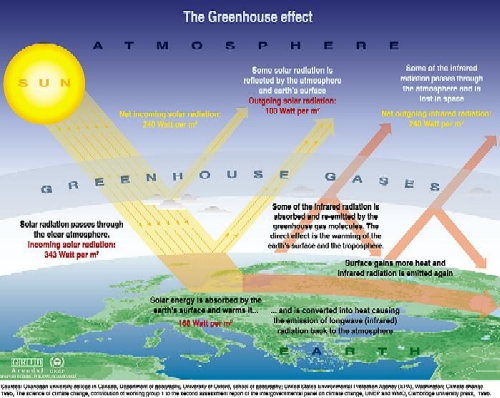(Part of the How to Talk to a Climate Skeptic guide)
Objection: The so called “Greenhouse Effect” which is the underpinning of the entire theory of anthropogenic global warming claims that greenhouse gases in the upper atmosphere absorb outgoing long-wave radiation from the surface and reradiate it back, thereby warming the climate. But the upper atmosphere is colder than the lower atmosphere and the surface and the second law of thermodynamics clearly requires that heat flow from warmer areas of a system to colder ones, the opposite direction that greenhouse theory requires. The cooler atmosphere can not radiate energy to the warmer surface. The greenhouse effect is a myth because it violates the second law of thermodynamics!
Answer:
No argument with the second law of thermodynamics here, that one seems to be on pretty solid ground! But the train of logic above has a subtle problem in its over statement of the constraints this law places on energy flow. Given a warmer and a cooler body exchanging energy either through convection or through radiation, the fact is, energy is constantly being exchanged in both directions. The second law of thermodynamics does not apply to individual molecules, it applies to the net flow of energy in the entire system. How could it be otherwise?
When an excited molecule of CO2 releases a photon, it does not somehow “know” which way to send it. It can not aim it towards a cooler body. It is simply released in a random direction. In the case of CO2 in the atmosphere, having absorbed some of the energy radiating towards space from the surface of the earth, this random choice of direction means that, roughly speaking, half of that energy is sent back. An individual molecule is not influenced at all by the temperature of the earth’s surface.
Where the second law does apply is in the net flow of heat, and this happens because a warmer body will send out more energy overall than it is receiving from the cooler one. Lots of energy going back and forth, but on balance more is leaving the warmer body.
The IPCC has provided this nice graphic of what is going on. They have also used the analogies of a blanket and a garden greenhouse in their FAQ sections.
In the case of the simplified earth-atmosphere system, the Earth’s surface warms from the sun’s incoming shortwave radiation. As it is now a warm body floating in cold space, Earth radiates long-wave energy back out at a rate that is dependent on its temperature. If that were the whole story, the earth would have balanced its incoming shortwave with its outgoing long-wave radiation at an average surface temperature of roughly -18°C and it would be a rather inhospitable place. As it is, the content of greenhouse gases in its atmosphere absorb some of that outgoing long-wave radiation and send it back down where we all live. The earth must balance this by warming enough so that it can radiate this additional energy back out again. The totality of this natural effect is around 33°C, bringing our average surface temperature to a comfortable +15°C.
So, it is not really like a blanket, which inhibits convection in both directions, or like an actual greenhouse, which lets in the sunlight and then also inhibits convection, but both are reasonable analogies as far as they go. The scientists in the IPCC know this, they are only using these analogies to help laypeople understand the very general principles. If you hear someone attacking climate science by attacking these analogies, they are attacking a strawman.
As we have added to the greenhouse effect, the planet’s surface must now warm until it reaches a new equilibrium temperature high enough to radiate out as much again as it is now receiving.
This is all very well established and long standing physics. No basic ignored mysteries, no violations of fundamental laws, just great explanations of naturally observed phenomena all over the solar system and beyond.
This is just one of dozens of responses to common climate change denial arguments, which can all be found at How to Talk to a Climate Skeptic.
“Greenhouse theory violates the laws of thermodynamics” is also posted on A Few Things Ill Considered, where additional comments can be found, and where the author, Coby Beck, is more likely to respond.


